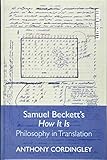Samuel Beckett's How It Is : Philosophy in Translation / Anthony Cordingley.
Material type: TextSeries: Other Becketts : OTBEPublisher: Edinburgh : Edinburgh University Press, [2022]Copyright date: ©2018Description: 1 online resource (304 p.)Content type:
TextSeries: Other Becketts : OTBEPublisher: Edinburgh : Edinburgh University Press, [2022]Copyright date: ©2018Description: 1 online resource (304 p.)Content type: - 9781474440608
- 9781474440622
- 843.91409
- PR6003.E282 Z6214 2018
- online - DeGruyter
| Item type | Current library | Call number | URL | Status | Notes | Barcode | |
|---|---|---|---|---|---|---|---|
 eBook
eBook
|
Biblioteca "Angelicum" Pont. Univ. S.Tommaso d'Aquino Nuvola online | online - DeGruyter (Browse shelf(Opens below)) | Online access | Not for loan (Accesso limitato) | Accesso per gli utenti autorizzati / Access for authorized users | (dgr)9781474440622 |
Frontmatter -- Contents -- List of Illustrations -- Series Editor’s Preface -- List of Abbreviations -- Introduction -- 1 A Poetics of Translation: Dante, Goethe and the Paideia -- 2 Pythagorean Mysticism / Democritean Wisdom -- 3 The Physical Cosmos: Aristotelian Dialectics -- 4 From the Cradle to the Cave: A Comedy of Ethics from Plato to Christian Asceticism (via Rembrandt) -- 5 Mystic Paths, Inward Turns -- 6 Pascal’s Miraculous Tongue -- 7 Spinoza, Leibniz or a World ‘less exquisitely organized’ -- Acknowledgements -- Bibliography -- Index
restricted access online access with authorization star
http://purl.org/coar/access_right/c_16ec
The first sustained exegesis of a neglected masterpiece of twentieth-century literature, Samuel Beckett’s How It IsOffers the first comprehensive treatment of Beckett’s most poorly understood novel, identifying the breadth of its philosophical and literary sourcesMakes extensive use of manuscript evidence and newly accessible notes from Beckett’s reading in philosophyGuides the reader through Beckett’s philosophical and theological sources, highlighting his innovative and original dialectics between the pre-Socratics, Plato, Aristotle, the Ancient Stoics, the early Church Fathers and desert mystics, seventeenth-century mystics and RationalistsThis book maps out the novel’s complex network of intertexts, sources and echoes, interprets its highly experimental writing and explains the work’s great significance for twentieth-century literature. It offers a clear pathway into this remarkable bilingual novel, identifying Beckett’s use of previously unknown sources in the history of Western philosophy, from the ancient and modern periods, and challenging critical orthodoxies. Through careful archival scholarship and attention to the dynamics of self-translation, the book traces Beckett’s transformation of his narrator’s ‘ancient voice’, his intellectual heritage, into a mode of aesthetic representation that offers the means to think beyond intractable paradoxes of philosophy. This shift in the work’s relation to tradition marks a hiatus in literary modernism, a watershed moment whose deep and enduring significance may now be appreciated.
Mode of access: Internet via World Wide Web.
In English.
Description based on online resource; title from PDF title page (publisher's Web site, viewed 29. Jun 2022)


